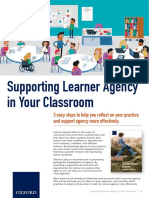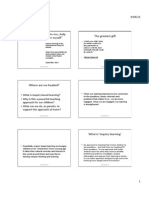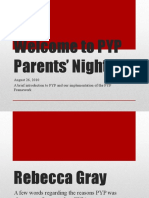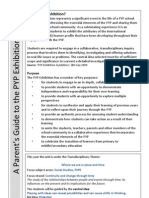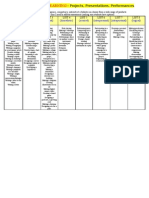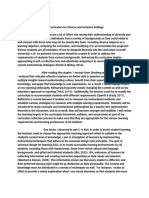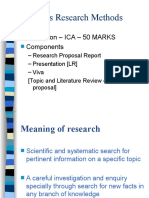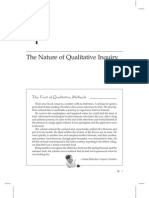Kath Inquiry PDF
Kath Inquiry PDF
Uploaded by
Sathyanand SwaminathanCopyright:
Available Formats
Kath Inquiry PDF
Kath Inquiry PDF
Uploaded by
Sathyanand SwaminathanOriginal Title
Copyright
Available Formats
Share this document
Did you find this document useful?
Is this content inappropriate?
Copyright:
Available Formats
Kath Inquiry PDF
Kath Inquiry PDF
Uploaded by
Sathyanand SwaminathanCopyright:
Available Formats
A basic overview of the Integrated Inquiry planning model (Kath Murdoch) 2007.
(Note: PHASES ARE BROADLY SEQUENTIAL. MOVEMENT BETWEEN THE PHASES IS EXPECTED) Importantly, the focus for the unit should be selected with a big picture in mind. School and state curriculum documents may assist. Foci will often be modified through negotiation with students or in conjunction with events or issues arising in the local or global community. Whats the inquiry really about? What is the key idea? What big question/s will we explore? This question has generative potential it is open and often provocative. (Imagine this question on your classroom wall) In some cases, students help devise the question. The question may be framed as a problem, a provocation, a wondering. What do we want students to understand more deeply by the end of the inquiry? What is important to know about this? (Link to big ideas) What key skills, strategies, qualities and values will be enriched through this inquiry? Link skills to generic areas: thinking, communication, selfmanagement, social, ICTs. Engagement and gathering prior knowledge, pre assessment, questions for inquiry, goal setting. Sometimes, students will require some early immersion or front loading in the topic if little is known/experienced. Some questions may emerge from students at this stage. What theories do we have? How do we already understand this? Ask students: how could we find out more about this? Use these to refine initial plans. Keep samples to help students self-assess. Spend time watching and listening. What are your students showing you? Where to now? Ideally, these conversations are carried out by a team of teachers prior to the inquiry, and revisited throughout the inquiry. Documentation should be reshaped as the inquiry unfolds. The frame of the inquiry must be informed by students. This planning should be displayed and made transparent to students.
Selection of topic or broad focus for an inquiry
Generative question/s
Understandings, Skills and values
Tuning in (to students, not just the topic!)
Finding out
Experiences and texts that add to knowledge base emphasis on gathering data first hand and in a range of ways (usually shared experiences) linked to understanding goals. Data gathering through engaging with experts, surveys, interviews, film, experiments, observations, field work Organising, analysing and communicating the information gathered using a range of learning areas eg: through maths, arts, English, drama, music, technology, etc. Reflective thinking work revising original theories and propositions. Reviewing the big questionWhat meaning can we make of this data? What are we learning? Raising or revisiting questions. Opportunity for students to pursue questions or issues/interests of their own or in small groups. These questions may be picked up from earlier in the inquiry or have emerged from the shared inquiry.
Involve students in deciding how you might find out more. Keep building banks of student questions
Sorting out
Students will be synthesizing their learning and beginning to make connections. Keep reviewing questions and initial thinking.
Going Further (independent inquiry)
The emphasis here is on choice and differentiation.
Drawing Conclusions
Stating understandings what do we think and know now? How do we feel? High level thinking about the topic. Identifying avenues for action and application. Generalising (should be done throughout) Now what? Taking action. Reflecting on the unit what how and why learning has come about? What did I learn about this topic? What did I learn about myself? What should I do now? (Reflect all the way through)
These phases are most often woven throughout the unit. Explicit connections must be articulated. Action may be shared or individual.
Reflecting and Acting
You might also like
- IB PYP ATL Scopes and SequencesDocument2 pagesIB PYP ATL Scopes and SequencesSCress100% (6)
- Enhanced PYP - Unit Planner PDFDocument1 pageEnhanced PYP - Unit Planner PDFManageBac100% (2)
- Single Subject Teacher Stages in Constructing Transdisciplinary Curriculum Copy-3Document3 pagesSingle Subject Teacher Stages in Constructing Transdisciplinary Curriculum Copy-3Skrtic100% (4)
- Learner Agency Teacher Activity SheetDocument4 pagesLearner Agency Teacher Activity SheetfriboNo ratings yet
- Gradual Release of Responsibility Doug FisherDocument4 pagesGradual Release of Responsibility Doug Fisherapi-239565419No ratings yet
- Inquirylearning Kath MurdochDocument5 pagesInquirylearning Kath Murdochapi-255097024No ratings yet
- PYP Planner Sharing The Planet PDFDocument4 pagesPYP Planner Sharing The Planet PDFIman Mansour100% (1)
- How The World Works-Pyp 3Document3 pagesHow The World Works-Pyp 3api-253737767No ratings yet
- Osmeña Ave., Victorias City, Negros Occidental Telefax No. (034) 399-2830Document27 pagesOsmeña Ave., Victorias City, Negros Occidental Telefax No. (034) 399-2830vividskyblueNo ratings yet
- Using Formative Assessment to Improve Student Outcomes in the ClassroomFrom EverandUsing Formative Assessment to Improve Student Outcomes in the ClassroomNo ratings yet
- Teaching Scaffolding To Early Childhood Educators: Action Research in Supportive Learning PracticesFrom EverandTeaching Scaffolding To Early Childhood Educators: Action Research in Supportive Learning PracticesNo ratings yet
- Kath Murdoch - Setting Personal Learning Goals 1Document1 pageKath Murdoch - Setting Personal Learning Goals 1api-380030046No ratings yet
- PYP For New ParentsDocument23 pagesPYP For New ParentsDave Secomb100% (2)
- PYP ClassroomDocument1 pagePYP ClassroomCristinaNo ratings yet
- Inquiry in The PypDocument49 pagesInquiry in The PypPima Ajah100% (3)
- Vancouver WorkbookDocument44 pagesVancouver Workbookflute01100% (1)
- Kath Murdoch - ES Parent WorkshopDocument6 pagesKath Murdoch - ES Parent WorkshopInternational School ManilaNo ratings yet
- Evaluation of Pyp Planner RubricDocument4 pagesEvaluation of Pyp Planner Rubricapi-16307116100% (1)
- Final Uoi Ib Pyp FileDocument12 pagesFinal Uoi Ib Pyp Fileapi-597568531100% (1)
- 2020-21 Kramer Pre-K Who We AreDocument12 pages2020-21 Kramer Pre-K Who We AreDavyMa100% (2)
- PYP Parents NightDocument25 pagesPYP Parents NightNathan PopeNo ratings yet
- Learning Through Inquiry LeafletDocument2 pagesLearning Through Inquiry Leafletmusic23No ratings yet
- Developing The Learner ProfileDocument5 pagesDeveloping The Learner ProfileIanNo ratings yet
- Lesson Plan - How We Express OurselvesDocument16 pagesLesson Plan - How We Express Ourselvesneha100% (1)
- Pyp FaqDocument28 pagesPyp FaqGroots100% (2)
- 1st Where We Are in Place and TimeDocument5 pages1st Where We Are in Place and Timejanan_snyder100% (4)
- How We Organize OurselvesDocument1 pageHow We Organize OurselvesMariana Suarez100% (1)
- Unit 2-How The World WorksDocument5 pagesUnit 2-How The World WorksPushpita NandyNo ratings yet
- Parent Guide To Exhibition 2013Document2 pagesParent Guide To Exhibition 20136GDNo ratings yet
- Pyp Exhibition Orientation For StudentsDocument10 pagesPyp Exhibition Orientation For Studentsapi-234755766100% (1)
- Pyp Parent Introductory Session October 2013-2014Document23 pagesPyp Parent Introductory Session October 2013-2014api-238413409No ratings yet
- Pyp Exhibition Orientation For TeachersDocument4 pagesPyp Exhibition Orientation For Teachersapi-234755766No ratings yet
- 2 - How We Express Ourselves StorytellingDocument2 pages2 - How We Express Ourselves StorytellingMariam BazerbachiNo ratings yet
- Educ 5240 Group Project - PPTX - 2Document34 pagesEduc 5240 Group Project - PPTX - 2Ferdaws Saleh100% (1)
- Purposeful Tech Integration and Implementation in PypDocument17 pagesPurposeful Tech Integration and Implementation in PypJaspreet Kaur100% (1)
- EDUC 5270 Unit5 DF PDFDocument2 pagesEDUC 5270 Unit5 DF PDFSneha MishraNo ratings yet
- Differentiated Assessment in The PYPDocument2 pagesDifferentiated Assessment in The PYPCristinaNo ratings yet
- How We Express Ourselves NewsletterDocument2 pagesHow We Express Ourselves NewsletterNISTYear1100% (1)
- Unit of Inquiry For Preschool: Let's Be CreativeDocument11 pagesUnit of Inquiry For Preschool: Let's Be Creativeami1967100% (1)
- PRC-Inquiry in A Primary SettingDocument25 pagesPRC-Inquiry in A Primary SettingPushpita NandyNo ratings yet
- How We Express Ourselves - Landscape at NightDocument4 pagesHow We Express Ourselves - Landscape at NightReham0% (1)
- IB Unit Express YourselfDocument7 pagesIB Unit Express YourselfKathyNo ratings yet
- Pyp News Letter Sept 2014Document2 pagesPyp News Letter Sept 2014crdaymentNo ratings yet
- Gradual Release of Responsibility 3Document5 pagesGradual Release of Responsibility 3Plug SongNo ratings yet
- How We Express OurselvesDocument1 pageHow We Express OurselvesMariana SuarezNo ratings yet
- Report PYPDocument7 pagesReport PYPHeryien Salim100% (2)
- Portfolio-EDUC 5711-Unit 3 - Curriculum For Diverse and Inclusive SettingsDocument3 pagesPortfolio-EDUC 5711-Unit 3 - Curriculum For Diverse and Inclusive SettingsSquishy SooNo ratings yet
- PYP 6 Who We Are NewsletterDocument3 pagesPYP 6 Who We Are NewsletteryanyuliusNo ratings yet
- ICT Unit Planner - Year 3 Sharing The PlanetDocument1 pageICT Unit Planner - Year 3 Sharing The Planetdanny67% (3)
- Enhanced Pyp Overview PDFDocument10 pagesEnhanced Pyp Overview PDFRadhika RamanathanNo ratings yet
- Sample Pyp Planners - SipadelDocument4 pagesSample Pyp Planners - SipadelFukcOffNo ratings yet
- KG How We Express Ourselves 2020Document8 pagesKG How We Express Ourselves 2020ayesha aman100% (1)
- Co-Constructing Central IdeaDocument13 pagesCo-Constructing Central IdeamaryamNo ratings yet
- Unit 5 How The World Works Grades 3 4 Sy 2013-2014Document7 pagesUnit 5 How The World Works Grades 3 4 Sy 2013-2014api-264373083No ratings yet
- Unit 1 Weebly How The World WorksDocument1 pageUnit 1 Weebly How The World Worksapi-326996466No ratings yet
- Uoi 3 Parent LetterDocument7 pagesUoi 3 Parent Letterapi-265511182No ratings yet
- Sharing The Planet NewsletterDocument1 pageSharing The Planet NewslettermruokanenNo ratings yet
- Enhanced Planner Where We Are in Place and TimeDocument16 pagesEnhanced Planner Where We Are in Place and Timeasima100% (4)
- 1st Uoi Planner Where We Are in Place and Time 2010 2011 NewDocument4 pages1st Uoi Planner Where We Are in Place and Time 2010 2011 NewAlka SaxenaNo ratings yet
- Apresentacao PropeDocument22 pagesApresentacao PropeJefferson Rodrigues BarbosaNo ratings yet
- Action Research ScienceDocument17 pagesAction Research ScienceAshi sharmaNo ratings yet
- Definition of ResearchDocument2 pagesDefinition of Researchsrisaec100% (6)
- Class Program Grade 7Document11 pagesClass Program Grade 7Honleth Jheney MamarilNo ratings yet
- SIP (Training)Document40 pagesSIP (Training)Eleazar MionesNo ratings yet
- Michaela Wilcox - Reading Practical Research Planning and Design Chapter 1 2 PDocument3 pagesMichaela Wilcox - Reading Practical Research Planning and Design Chapter 1 2 Papi-535777172No ratings yet
- FSLM Undergraduate Research Project HandbookDocument11 pagesFSLM Undergraduate Research Project HandbookChimar DhineeshaNo ratings yet
- Soal UTS Metodologi PenelitianDocument2 pagesSoal UTS Metodologi PenelitianNova Lingga Pitaloka100% (1)
- Safety Data Sheet: TR Requisition NR: 0856417013 Doc. Number: FAC10005-CHI-000-PCS-DTS-0001 Rev: Sheet 18 of 23Document6 pagesSafety Data Sheet: TR Requisition NR: 0856417013 Doc. Number: FAC10005-CHI-000-PCS-DTS-0001 Rev: Sheet 18 of 23Bn BnNo ratings yet
- Pensum ElectronicaDocument1 pagePensum ElectronicaOscar DiazNo ratings yet
- 1 PreliminariesDocument7 pages1 PreliminariesArmen TentiaNo ratings yet
- (Tittle) : Jurnal Skala Husada...........................Document5 pages(Tittle) : Jurnal Skala Husada...........................GusariManuabaNo ratings yet
- Practical Research 2Document17 pagesPractical Research 2STEPHEN JAMES RONCESVALLES LIZANo ratings yet
- 1 Nature of Inquiry and ResearchDocument7 pages1 Nature of Inquiry and ResearchInna Sanvictores67% (3)
- Vol 19 No 11 November 2020Document302 pagesVol 19 No 11 November 2020ijlter.orgNo ratings yet
- Assessment Part IIDocument3 pagesAssessment Part IImaeg07No ratings yet
- 英語100篇精讀薈萃(高級篇)Document34 pages英語100篇精讀薈萃(高級篇)tpopera100% (4)
- Business Research Methods: Evaluation - ICA - 50 MARKS ComponentsDocument39 pagesBusiness Research Methods: Evaluation - ICA - 50 MARKS ComponentsSHARMA NIKHILNo ratings yet
- Jeremy Black Studying HistoryDocument255 pagesJeremy Black Studying HistoryDolog Silou100% (1)
- The Research Methods: Let Us Look at What The Online Sources Tell UsDocument9 pagesThe Research Methods: Let Us Look at What The Online Sources Tell UsCyrill Mico De GuzmanNo ratings yet
- Gr. 7 Science TG (Q1 To 4)Document224 pagesGr. 7 Science TG (Q1 To 4)Qwyn Vylette Sanson67% (9)
- Teaching Social Studies in Elementarey GradesDocument23 pagesTeaching Social Studies in Elementarey GradesLaura Mae Satorre100% (1)
- Minutes of Online Meeting - 10th September - 2020Document8 pagesMinutes of Online Meeting - 10th September - 2020aponNo ratings yet
- NMHS30970 EBP Workbook 2017-18Document52 pagesNMHS30970 EBP Workbook 2017-18Aj AquinoNo ratings yet
- The Art of Effective QuestioningDocument39 pagesThe Art of Effective QuestioningBert EngNo ratings yet
- Appendices & CVDocument27 pagesAppendices & CVIka Ng SuyNo ratings yet
- BAED Research Grade 12 2122Document33 pagesBAED Research Grade 12 2122Luisa RadaNo ratings yet
- Patton Chapter 1Document34 pagesPatton Chapter 1geog83100% (1)
- To Inquire Into The Following: Transdisciplinary Theme: 1. What Is Our Purpose?Document4 pagesTo Inquire Into The Following: Transdisciplinary Theme: 1. What Is Our Purpose?Amna AdnanNo ratings yet



